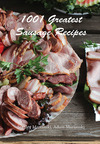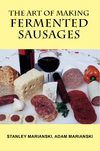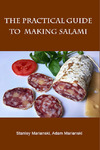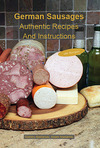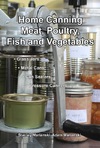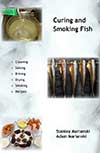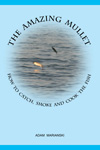Meats and Sausages
Mortadella - Süddeutsch (German Southern Mortadella)
Süddeutsche Mortadella is a popular sausage in the southern part of Germany. Southern and northern mortadellas employ similar selection of spices, but there are red inserts of cured tongue in southern mortadella.
| Materials | Metric | US |
|---|---|---|
| Lean pork | 300 g | 0.66 lb |
| Medium-fat pork | 200 g | 0.44 lb |
| Pork jowls or pork rich in connective tissue | 200 g | 0.44 lb |
| Pork tongue | 100 g | 0.22 lb |
| Pork back fat | 100 g | 0.22 lb |
| Water | 100 g | 3.33 oz fl |
Ingredients per 1000g (1 kg) of materials
| Salt | 16 g | 2.5 tsp |
| Cure #1 | 2.5 g | 1/2 tsp |
| White pepper | 2.0 g | 1 tsp |
| Paprika, sweet | 0.5 g | 1/4 tsp |
| Coriander | 0.5 g | 1/4 tsp |
| Mace | 0.5 g | 1/4 tsp |
| Cardamom | 0.3 g | 1/8 tsp |
| Ginger | 0.3 g | 1/8 tsp |
| Red bell peppers | 15 g | 1/2 oz |
| Pistachios | 15 g | 1/2 oz |
Instructions
- Dice cured tongues* into 25 mm (1") cubes.
- Dice partially frozen back fat into 12 mm (1/2") cubes.
- Remove seed from red peppers, then dice the peppers into 1 cm (1/2") squares. Dry for one day to remove moisture.
- Grind lean pork, medium-fat pork and pork jowls through 3 mm (1/8") plate. Mix with salt, cure #1 and water. Add diced cured tongues, all ingredients and mix again. Finely add diced back fat and mix again.
- Stuff into 80-90 mm synthetic casings making 50 cm (20") sections.
- Hold for 2 hours at room temperature.
- Boil in water at 80° C (176° F) for 90 minutes.
Notes
* curing tongues. Make 40° Salometer brine (10° Baume):
1 gal water, 333 g (0.73 lb) salt, 120 g (4.2 oz) Cure #1.
About 1 quart of curing solution is needed for 1 kg of meat.
Inject some brine into tongues so they gain about 10% of their original gain and then place them in brine in a suitable container. Hold them completely submerged for 48 hours. Remove the skin from the tongues, then slice them into thick discs. Boil the tongues at 90° C (194° F) for about 2 hours. Cool the tongues under running water.
About 1 quart of curing solution is needed for 1 kg of meat.
Inject some brine into tongues so they gain about 10% of their original gain and then place them in brine in a suitable container. Hold them completely submerged for 48 hours. Remove the skin from the tongues, then slice them into thick discs. Boil the tongues at 90° C (194° F) for about 2 hours. Cool the tongues under running water.




